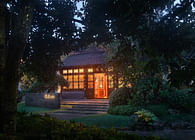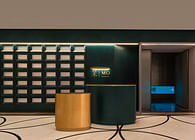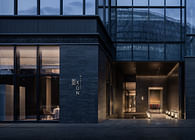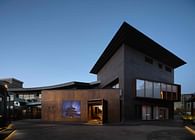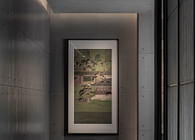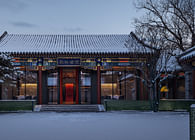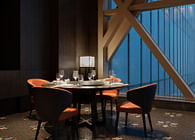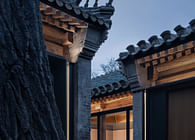
Beijing Shi, CN
LDH DESIGN | The Nature Flow
Double butterflies were embroidered on her silk skirt. At the Dongchi banquet, we first met each other. Her delicate face was lightly powdered, like a faint spring flower, bathed in the gentle fragrance of spring.
-- Song Dynasty·Zhang Xian
The concept of natural dining: Eating in accordance with the seasons, avoiding foods that are out of season. We strive to discover the finest ingredients from around the world and seek the most authentic culinary techniques.
Savoring Through Presentation
With a touch of cinnabar leading the way, resembling a hem, it slowly parades on the canvas of grayish blue, moving gracefully and drawing people into the painting. The dynamic geometric facade, combined with the rich vermilion color, represents the brand's distinctive overall presentation. The cleverly designed entrance, the long and mysterious corridor, and the gradually revealed natural light make one feel like they are entering an art gallery. As you open the box of paintings, you are already immersed in the picturesque landscape of Jiangxia(ancient Wuhan).
With its ancient-style pitched roof, it exudes a sense of antiquity. Sitting with good friends on the platform, looking through the clean and transparent large glass windows, it feels as if we are in another world, transcending time. Right here, within this glass pane, lies today's Wuhan on the outside, while inside, it's a picturesque Jiangxia steeped in history.
With cinnabar-infused brushstrokes, depicting a jade plate
The original square layout now offers greater room for creative expression. With flowing brushstrokes like a wandering dragon and the infusion of cinnabar ink, the design process begins from the narrow corridor at the reception on the first floor, connecting multiple axes, dividing areas, dispersing tables, bars, and tea stations, all organized in a clear and open manner. Within the space, rectangles or squares fill the area, with grid patterns on the ceiling, extending rectangles on the façade, and mosaic patterns on the floor. Each square frames a corner of Jiangxia's historical landscape.
The unique design of the scattered tables creates focal points within the space, providing artistic highlights. Large floor-to-ceiling windows allow the natural light to pour in, as if a pair of hands opening the pages of an art book, brushing away the dust to reveal the light of days gone by.
Ascending the stairs paved with grayish-blue stones, one enters the second floor. The reception area continues the rectangular design language, incorporating a clearer layout of axes into the space. Corridors divide functional areas, and each private room is both independent and interconnected. The well-defined linear layout tells the story of Wuhan's historical and contemporary life scenes.
The layout on the third floor is circular, adopting the form of a traditional Chinese garden's cloister, connecting the central private room area and the terrace with a long corridor. Moving around offers changing scenes, connecting the river's poetic beauty, creating a long-lasting painting.
Green color portrays essence, for people all over the world to appreciate.
The use of related terms to the traditional Chinese Five Elements and Five Colors system is highly frequent in 'The Officially Compiled Tang Poetry Anthology,' reflecting the Tang Dynasty people's ability to distinguish various colors and the values and aesthetics that emerged from it. Among these colors, '青' (qing, blue/green) takes the first place in the Five Elements and Five Colors system. Color-related words in the blue/green spectrum also have a high frequency of occurrence in 'The Complete Tang Poems.' Over the course of its long history, blue/green gradually evolved into a color symbol, serving as a means to express various forms of corresponding emotions, subjective experiences, and inner qualities in ancient human life.
With a simple and natural green as the dominant tone, complemented by large areas of vermilion fabric wall coverings, the overall ambiance creates an elegant and rustic eastern atmosphere. At the entrance, the green-black marble floor and vermilion-red wall form a striking contrast, captivating the visitors. These two highly contrasting colors are boldly and unapologetically displayed, showcasing the grace and magnanimity of the entire Chinese culture. Upon entering the lobby, the orderly arrangement of linguistic forms interprets the design's breaking and reconstruction of ceremonial and formal structures: a sequence arranged along the axis → the use of vertical cylindrical blocks. In breaking the traditional mold, a new order is constructed, seeking harmony in the diversity of spatial forms. In terms of lighting fixtures, a variety of palace-style lamp shapes have been selected, harmonizing with the ancient charm and elegance of the space.
As you ascend the steps to a higher place, you encounter the color green once again. Within the warm vermilion aura, the road paved with bluestone seems to gently recount past stories. Each private room is adorned with narratives that whisper in your ears, some elegant and refined, others vibrant and rich, and some warm and lovely. In the sky-blue misty rain, it's the anticipation by the vast window, and it's also the vision of a bright future by the heroic riverside. The river's reflection, framed through the glass, captures your figure. In front of the warm wooden wall, it's the joyful gathering around the table, where red gauze envelops your heartwarming emotions.
Even more so, in the quiet of late night, under the tranquil glow of lamplight, standing with a few friends, savoring tea and wine, gazing at the river's fishing lamps from a high vantage point, we raise our glasses to the indomitable spirit by the riverside. Woodwork, stonework, softness and hardness in contrast; metal, fabric, inclusiveness and diversity; green and red intersect here, narrating the human stories and worldly affairs, the past and present charm of Jiangxia.
LDH DESIGN deconstructs the color symbols of Danqing( Colors of Vermilion and Turquoise) to extend the cultural continuity and inheritance of ancient and modern Wuhan. Through the contemporary design language of 'experientialism,' it conveys local cultural connotations, redefines brand innovation, and explores brand vitality. Seeking breakthroughs in tradition and innovation, it uses an inclusive structural language and a stable and elegant color composition to create scene vitality and spatial charm in the local context. In the ever-changing flow between people and people, spaces and scenes, taste buds and moods, it sparks the portrayal and imagination of new life and new memories.
Status: Built
Location: Wuhan, CN
Firm Role: interior design
Additional Credits: Space Design: LDH DESIGN (www.ldhdesign.cn)
Chief Designer: Liu Daohua
Furniture Consultant: San Yi He Mei
Photographer: He Chuan
